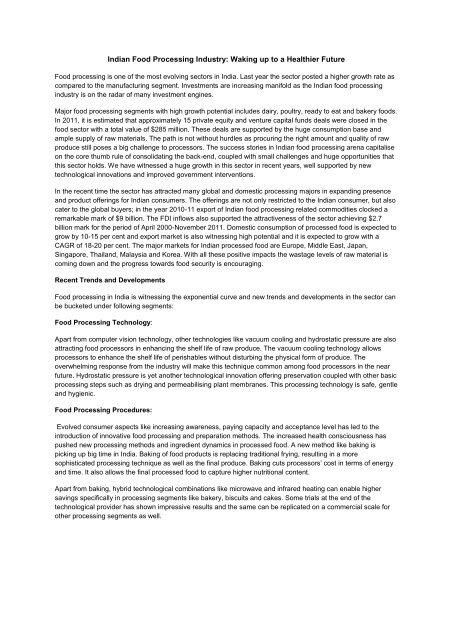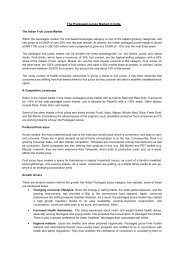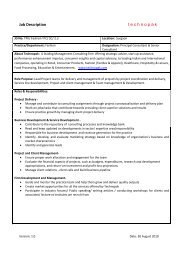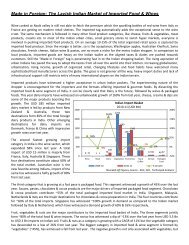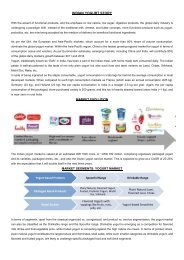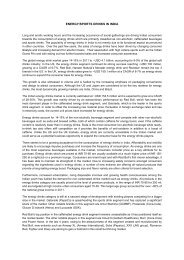Indian Food Processing Industry: Waking up to a ... - Technopak
Indian Food Processing Industry: Waking up to a ... - Technopak
Indian Food Processing Industry: Waking up to a ... - Technopak
You also want an ePaper? Increase the reach of your titles
YUMPU automatically turns print PDFs into web optimized ePapers that Google loves.
<strong>Indian</strong> <strong>Food</strong> <strong>Processing</strong> <strong>Industry</strong>: <strong>Waking</strong> <strong>up</strong> <strong>to</strong> a Healthier Future<br />
<strong>Food</strong> processing is one of the most evolving sec<strong>to</strong>rs in India. Last year the sec<strong>to</strong>r posted a higher growth rate as<br />
compared <strong>to</strong> the manufacturing segment. Investments are increasing manifold as the <strong>Indian</strong> food processing<br />
industry is on the radar of many investment engines.<br />
Major food processing segments with high growth potential includes dairy, poultry, ready <strong>to</strong> eat and bakery foods.<br />
In 2011, it is estimated that approximately 15 private equity and venture capital funds deals were closed in the<br />
food sec<strong>to</strong>r with a <strong>to</strong>tal value of $285 million. These deals are s<strong>up</strong>ported by the huge consumption base and<br />
ample s<strong>up</strong>ply of raw materials. The path is not without hurdles as procuring the right amount and quality of raw<br />
produce still poses a big challenge <strong>to</strong> processors. The success s<strong>to</strong>ries in <strong>Indian</strong> food processing arena capitalise<br />
on the core thumb rule of consolidating the back-end, co<strong>up</strong>led with small challenges and huge opportunities that<br />
this sec<strong>to</strong>r holds. We have witnessed a huge growth in this sec<strong>to</strong>r in recent years, well s<strong>up</strong>ported by new<br />
technological innovations and improved government interventions.<br />
In the recent time the sec<strong>to</strong>r has attracted many global and domestic processing majors in expanding presence<br />
and product offerings for <strong>Indian</strong> consumers. The offerings are not only restricted <strong>to</strong> the <strong>Indian</strong> consumer, but also<br />
cater <strong>to</strong> the global buyers; in the year 2010-11 export of <strong>Indian</strong> food processing related commodities clocked a<br />
remarkable mark of $9 billion. The FDI inflows also s<strong>up</strong>ported the attractiveness of the sec<strong>to</strong>r achieving $2.7<br />
billion mark for the period of April 2000-November 2011. Domestic consumption of processed food is expected <strong>to</strong><br />
grow by 10-15 per cent and export market is also witnessing high potential and it is expected <strong>to</strong> grow with a<br />
CAGR of 18-20 per cent. The major markets for <strong>Indian</strong> processed food are Europe, Middle East, Japan,<br />
Singapore, Thailand, Malaysia and Korea. With all these positive impacts the wastage levels of raw material is<br />
coming down and the progress <strong>to</strong>wards food security is encouraging.<br />
Recent Trends and Developments<br />
<strong>Food</strong> processing in India is witnessing the exponential curve and new trends and developments in the sec<strong>to</strong>r can<br />
be bucketed under following segments:<br />
<strong>Food</strong> <strong>Processing</strong> Technology:<br />
Apart from computer vision technology, other technologies like vacuum cooling and hydrostatic pressure are also<br />
attracting food processors in enhancing the shelf life of raw produce. The vacuum cooling technology allows<br />
processors <strong>to</strong> enhance the shelf life of perishables without disturbing the physical form of produce. The<br />
overwhelming response from the industry will make this technique common among food processors in the near<br />
future. Hydrostatic pressure is yet another technological innovation offering preservation co<strong>up</strong>led with other basic<br />
processing steps such as drying and permeabilising plant membranes. This processing technology is safe, gentle<br />
and hygienic.<br />
<strong>Food</strong> <strong>Processing</strong> Procedures:<br />
Evolved consumer aspects like increasing awareness, paying capacity and acceptance level has led <strong>to</strong> the<br />
introduction of innovative food processing and preparation methods. The increased health consciousness has<br />
pushed new processing methods and ingredient dynamics in processed food. A new method like baking is<br />
picking <strong>up</strong> big time in India. Baking of food products is replacing traditional frying, resulting in a more<br />
sophisticated processing technique as well as the final produce. Baking cuts processors’ cost in terms of energy<br />
and time. It also allows the final processed food <strong>to</strong> capture higher nutritional content.<br />
Apart from baking, hybrid technological combinations like microwave and infrared heating can enable higher<br />
savings specifically in processing segments like bakery, biscuits and cakes. Some trials at the end of the<br />
technological provider has shown impressive results and the same can be replicated on a commercial scale for<br />
other processing segments as well.
Government Intervention<br />
<strong>Indian</strong> government has also considered food processing as one of the major investment sec<strong>to</strong>rs. The huge<br />
budgetary allocation for the sec<strong>to</strong>r has been fixed at `660 crore for the fiscal, <strong>up</strong> from `600 crore in 2011- 12. New<br />
initiatives and schemes have been floated from different ministries and aligned government agencies on a<br />
frequent basis. Now the schemes and initiatives are more realistic than before generating greater interest among<br />
the bigger players.<br />
One of the new initiatives for food processing industry stakeholders is the National Mission on <strong>Food</strong> <strong>Processing</strong>.<br />
Under this mission the MoFPI is planning <strong>to</strong> increase the contribution of the state government through s<strong>up</strong>port<br />
participation for food processing activities. The effort will increase central and state level activity coordination<br />
resulting in betterment of food processing landscape. It will also s<strong>up</strong>port the outreach of processed products. At<br />
the same time it will provide more flexibility <strong>to</strong> suit local needs. The mission aims <strong>to</strong> set <strong>up</strong> food processing units<br />
on a large scale from state government while technological and logistical s<strong>up</strong>port will be provided by the central<br />
government. Detailing the technological and logistics s<strong>up</strong>port, central government will aid in technological <strong>up</strong>gradation,<br />
skill development, promotional activities and non-horticultural cold s<strong>to</strong>rage infrastructure. Currently the<br />
draft schemes have been approved and the facilitation will commence in August-September. The initial feedback<br />
on the mission from various state governments is extremely encouraging and the mission s<strong>up</strong>ports the<br />
philosophy of decentralisation, greater participation of state governments, convergence of various programmes<br />
and implementing the schemes in the mission mode instead of routine vertical programmes.<br />
Apart from National Mission on <strong>Food</strong> <strong>Processing</strong>, the government is also planning <strong>to</strong> provide food processing<br />
sec<strong>to</strong>r the status of priority-sec<strong>to</strong>r lending, for specific projects involved in processing of perishable products.<br />
These interventions will be an addition <strong>to</strong> the existing duty exemptions and FDI s<strong>up</strong>port <strong>to</strong> promote food<br />
processing as investment poised sec<strong>to</strong>r in India.<br />
<strong>Food</strong> and agriculture has been a relevant <strong>to</strong>pic of discussion in the <strong>Indian</strong> economic scenario for a very long time.<br />
A country feeding 1200 million people will need robust production, preservation and distribution functions.<br />
Infrastructures s<strong>up</strong>porting these functions are not robust and need a lot of addition and <strong>up</strong>-gradation. <strong>Food</strong><br />
processing has emerged as one of the rescue <strong>to</strong>ols <strong>to</strong> reduce wastage and achieving maximum reach from the<br />
limited production. It has taken the <strong>Indian</strong> consumer a long time <strong>to</strong> accept the perception of nutritive value delta in<br />
processed food vis-a-vis fresh food. But with the consumer evolving, the situation is brighter for the industry. In<br />
coming years, processed food will achieve higher penetration in the monthly household consumption basket and<br />
the same will help in stabilising price sensitivity and dependence on perishables.<br />
Authored By:<br />
Pratichee Kapoor – Associate Vice President, <strong>Food</strong> services & Agriculture<br />
Aneesh Saraiya – Senior Consultant, <strong>Food</strong> services & Agriculture


